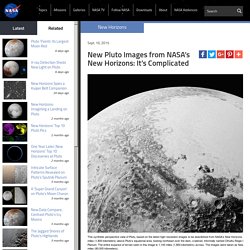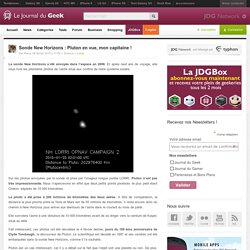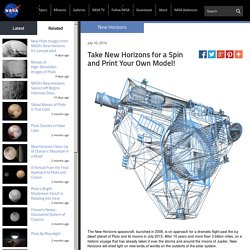

New Horizons : sonder les confins du système solaire. Ultima Thulé, surprenant « bonhomme de neige » rouge aux confins du système solaire. NASA just woke up a nuclear-powered probe 1 billion miles beyond Pluto — and it's approaching the farthest object humans have ever tried to visit. New Horizons. NEW HORIZONS [Extended Version] What did NASA's New Horizons discover around Pluto? Pluton, une odyssée mouvementée. Après Pluton, la sonde New Horizons a trouvé sa nouvelle cible.
New Horizons capture des images de Pluton ultra détaillées. Perplexing Pluto: New ‘Snakeskin’ Image and More from New Horizons. The newest high-resolution images of Pluto from NASA’s New Horizons are both dazzling and mystifying, revealing a multitude of previously unseen topographic and compositional details.

The image below -- showing an area near the line that separates day from night -- captures a vast rippling landscape of strange, aligned linear ridges that has astonished New Horizons team members. “It’s a unique and perplexing landscape stretching over hundreds of miles,” said William McKinnon, New Horizons Geology, Geophysics and Imaging (GGI) team deputy lead from Washington University in St.
Louis. “It looks more like tree bark or dragon scales than geology. This’ll really take time to figure out; maybe it’s some combination of internal tectonic forces and ice sublimation driven by Pluto’s faint sunlight.” New Pluto Images from NASA’s New Horizons: It’s Complicated. Scientists using NASA’s Chandra X-ray Observatory have made the first detections of X-rays from Pluto.

These observations offer new insight into the space environment surrounding the largest and best-known object in the solar system’s outermost regions. While NASA’s New Horizons spacecraft was speeding toward and beyond Pluto, Chandra was aimed several times on the dwarf planet and its moons, gathering data on Pluto that the missions could compare after the flyby. Each time Chandra pointed at Pluto – four times in all, from February 2014 through August 2015 – it detected low-energy X-rays from the small planet. The first detection of Pluto in X-rays has been made using NASA’s Chandra X-ray Observatory in conjunction with observations from NASA’s New Horizon spacecraft.
Credits: X-ray: NASA/CXC/JHUAPL/R.McNutt et al; Optical: NASA/JHUAPL Pluto is the largest object in the Kuiper Belt, a ring or belt containing a vast population of small bodies orbiting the Sun beyond Neptune. Sonde New Horizons : Pluton en vue, mon capitaine ! La sonde New Horizons a été envoyée dans l’espace en 2006.

Et après neuf ans de voyage, elle nous livre les premières photos de l’astre situé aux confins de notre système solaire. Sur les photos envoyées par la sonde et prise par l’imageur longue portée LORRI, Pluton n’est pas très impressionnante. Nous n’apercevons en effet que deux petits points pixelisés -le plus petit étant Charon- séparés de 15 000 kilomètres.
La photo a été prise à 200 millions de kilomètres des deux astres. A titre de comparaison, la distance la plus proche entre la Terre et Mars est de 55 millions de kilomètres. Elle survolera l’astre à une distance de 10 000 kilomètres avant de se diriger vers la ceinture de Kuiper, situé au delà. Fait intéressant, ces photos ont été dévoilées le 4 février dernier, jours du 109 ème anniversaire de Clyde Tombaugh, le découvreur de Pluton. Take New Horizons for a Spin and Print Your Own Model! Artist conception of New Horizons Spacecraft.

Credits: Johns Hopkins University Applied Physics Laboratory/Southwest Research Institute What's icy, has "wobbly" potato-shaped moons, and is arguably the world's favorite dwarf planet? The answer is Pluto, and NASA's New Horizons is speeding towards the edge of our solar system for a July 14 flyby. It won’t be making observations alone; NASA's fleet of observatories will be busy gathering data before and after to help piece together what we know about Pluto, and what features New Horizons data might help explain. "NASA is aiming some of our most powerful space observatories at Pluto,” said Paul Hertz, Astrophysics Division Director at NASA Headquarters, Washington. Right around New Horizons’ closest approach to Pluto, Cassini will take an image of the dwarf planet from its station in orbit around Saturn.
Who would expect tiny Pluto to generate X-rays? Even after New Horizons flies past Pluto, the observations don't end there. Charon, l’énigmatique lune de Pluton, se révèle en vidéo.